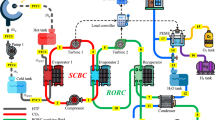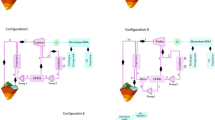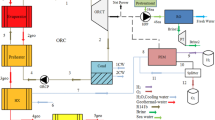Abstract
With the ever-rising paces of fuel consumption and CO2 emission, the urge for renewable energy resources is becoming a challenge in today’s world; especially for Iran that has started to reduce its fuel subsidies. The need for electricity and fresh water in the southern coastal regions of the country is increasing with the increase in the population. The high solar radiation level in the region is a promising alternative to mitigate the fuel consumption of the conventional power or desalination plants by the solar thermal source through the concentrated solar technology. In addition, the CO2 emission of the aforementioned plants significantly diminishes by using the molten carbonate fuel cell that is suitable for the CO2 capture. Furthermore, the combination of different power and water technologies, which are operating at different temperatures and pressures, leads to enhance the overall efficiency of the integrated systems. To this end, a novel integrated power/water plant comprising a solar tower, a molten carbonate fuel cell, a gas turbine, a solar Rankine cycle, an organic Rankine cycle, a multi-effect distillation, and reverse osmosis desalination was techno-economically investigated. The multi-objective genetic algorithm was used to find the optimum configuration of the system with the low amount of CO2 emissions, and low unit costs of the electricity and fresh water. The results showed that the most effective parameter on system performance is the operating pressure of the molten carbonate fuel cell. For the optimum configurations of the system, the electricity unit of the cost was found as a value between 0.022 and 0.025 $/kWh. Part of the electricity unit of the cost that is associated with the output power that is generated based on solar thermal energy was obtained as a value between 0.08 and 0.092 $/kWh. In addition, the average unit cost of fresh water was obtained as 1.21 $/m3. The payback period of the system was obtained as 10.44 years if the electricity and fresh water are sold as 0.023 $/kWh and 1.21 $/m3. This can be reduced to 2.88 years for the electricity and fresh water selling prices of 0.069 $/kWh and 1.40 $/m3, respectively. Based on the results, the system with the solar thermal resource will be economically justifiable if the fuel price is increased.




















Similar content being viewed by others
Abbreviations
- AB:
-
after burner
- Ah:
-
heliostat area
- CC:
-
combined cycle
- Ch:
-
heliostat concentration
- CRF:
-
capital recovery factor
- CSP:
-
concentrated solar power
- DC:
-
direct cost
- DNI:
-
direct normal irradiance (W/m2)
- EG:
-
annual electricity generation (kWh/yr)
- FC:
-
fuel cell
- GT:
-
gas turbine
- HRSG:
-
heat recovery steam generator
- ID:
-
indirect cost
- ISCCs:
-
integrated solar combined cycle power plant
- LCOE:
-
levelized cost of electricity, $/kWh
- LCOW:
-
levelized cost of water, $/m3
- LF:
-
linear Fresnel
- MCFC:
-
molten carbonate fuel cell
- MED:
-
multi effect distillation
- MOEA:
-
multi-objective optimization evolutionary algorithms
- NGB:
-
natural gas boiler
- ORC:
-
organic Rankine cycle
- PEMFC:
-
proton exchange membrane fuel cell
- P max :
-
SRC maximum pressure
- PV:
-
photovoltaic modules
- PTC:
-
parabolic trough
- RO:
-
reverse osmosis
- SGSS:
-
steam generation subsystem
- SPB:
-
simple payback time
- SMP:
-
specific market price
- SOFC:
-
solid oxide fuel cell
- SRC:
-
steam Rankine cycle
- ST:
-
solar tower
- TES:
-
thermal energy storage
- TVC:
-
thermal vapor compression
- a:
-
diode ideality factor
- Gn :
-
surface irradiance at standard test (W/m2)
- i:
-
interest rate
- k:
-
Boltzmann constant
- Kv :
-
open circuit voltage temperature coefficient
- q:
-
Electron charge
- Ru :
-
Universal gas constant
References
Ahmadi R, Pourfatemi SM, Ghaffari S (2017) Exergo economic optimization of hybrid system of GT, SOFC and MED implementing genetic algorithm. Desalination 411:76–88
Arsalis A, Von Spakovsky MR, Calise F (2009) Thermoeconomic modeling and parametric study of hybrid solid oxide fuel cell-gas turbine-steam turbine power plants ranging from 1.5MWe to 10MWe. J Fuel Cell Sci Technol 6(1):011015–011027
Baniasad Askari I, Ameri M (2009) Optimal sizing of stand alone (Photovoltaic/Battery) power systems in a remote region in Kerman, Iran. Proc IMechE, Part A: J Power Energy 223:563–570
Baniasad Askari I, Ameri M (2011a) Thechno-economic feasibility analysis of stand-alone renewable energy systems (PV/bat, wind/bat and hybrid PV/wind/bat) in Kerman, Iran. Energy Sources B: Econ Plan Pol 3:357–377
Baniasad Askari I, Ameri M (2011b) Effect of fuel price on economic analysis of hybrid (photovoltaic/diesel/battery) systems in Iran. Energy Sources Part B: Econ Plan Policy 11:357–377
Baniasad Askari I, Ameri M (2016) Techno economic feasibility analysis of MED/TVC desalination unit powered by linear fresnel solar field direct steam. Desalination 394:1–17
Baniasad Askari I, Ameri M (2017) The application of linear Fresnel and parabolic trough solar fields as thermal source to produce electricity and fresh water. Desalination 415:90–103
Baniasad Askari I, Ameri M (2018a) Solar Rankin Cycle (SRC) Powered by linear fresnel solar field and integrated with combined MED desalination system. Renew Energy 117:52–70
Baniasad Askari I, Ameri M (2018b) Combined linear Fresnel solar Rankine cycle with multi effect desalination (MED) process: effect of solar DNI level on the electricity and water production cost. Desalin Water Treat 126:97–115
Baniasad Askari I, Ameri M (2021) A techno-economic review of Multi Effect Desalination (MED) systems and solar thermal source/MED plants. Appl Therm Eng 185(2021):116323
Baniasad Askari I, Oukati Sadegh M, Ameri M (2014) Effect of heat storage and fuel price on energy management and economics of micro CCHP cogeneration systems. J Mech Sci Technol 28:1–12
Baniasad Askari I, Oukati Sadegh M, Ameri M (2015) Energy Management and Economics of a Trigeneration System: Considering the Effect of Solar PV, Solar collector and Fuel Price. Energy Sustain Develop 26:43–55
Baniasad Askari I, Ameri M, Calise F (2018c) Energy, exergy and exergo-economic analysis of different water desalination technologies powered by Linear Fresnel solar field. Desalination 428:37–67
Baniasad Askari I, Calise F, Vicidomini M (2019) Design and comparative techno-economic analysis of two solar polygeneration systems applied for electricity, cooling and fresh. Energies 12(22):4401
Baranak M, Atakül H (2007) A basic model for analysis of molten carbonate fuel cell behavior. J Power Sources 172(2):831–839
Calise F, Accadia MD, Macaluso A, Piacentino A, Vanoli L (2016) Exergetic and exergue conomic analysis of a novel hybrid solar–geothermal poly generation system producing energy and water. Energy Convers Manag 115:200–220
Calise F, Macaluso A, Piacentino A, Vanoli L (2017) A novel hybrid poly generation system supplying energy and desalinated water by renewable sources in Pantelleria Island. Energy 137:1086–1106
Çengel, Yunus A (2008) Thermodynamics: an Engineering Approach. McGraw-Hill Higher Education, Boston
Chan SH, HoH K, Tian Y (2002) Modelling of simple hybrid solid oxide fuel cell and gas turbine power plant. J Power Sources 109:111–120
Choi JH, Ahn JH, Kim TS (2014) Performance of a triple power generation cycle combining gas/steam turbine combined cycle and solid oxide fuel cell and the influence of carbon capture. Appl Therm Eng 71:301–309
DiNenno PhJ, Drysdale D, Beyler CL, Walton WD, Custer RLP, Hall JR, Watts JM (2002) SFPE Handbook of Fire Protection Engineering, Third Edition, National Fire Protection Association
El-Emam RS, Dincer I (2018) Development and assessment of a novel solar heliostat based multigeneration system. Int J Hydrog Energy 43:2610–2620
Fichtner and DLR (2011) MENA Regional Water Outlook, Part II, Desalination Using Renewable Energy, Task 1—Desalination Potential; Task 2—Energy Requirements; Task 3—Concentrate Management: http://www.dlr.de/tt/Portaldata/41/Resources/dokumente/institut/system/projects/MENA_REGIONAL_WATER_ OUTLOOK.pdf
Fonseca CM, Fleming PJ (1998) Multi objective optimization and multiple constraint handling with evolutionary algorithms _ Part I: a unified formulation. IEEE Transact Syst Man Cyber 28:26–37
Franchini G, Perdichizzi A, Ravelli S, Barigozzi G (2013) A comparative study between parabolic trough and solar tower technologies in Solar Rankine Cycle and Integrated Solar Combined Cycle plants. Sol Energy 98:302–314
Ganapathy V (1990) Simplify heat recovery steam generator evaluation, ABCO Industries, Abilene, Texas, Hydrocarbon Processing
Gomez-Hernandez J, Gonzales-Gomez PA, Briongos JV, Santana D (2018) Influence of the steam generator on the exergetic and exergo economic analysis of solar tower plants. Energy 145:313–328
Gorjian S, Ghobadian B, Tavakkoli Hashjin T, Banakar A (2014) Experimental performance evaluation of a stand-alone point-focus parabolic solar still. Desalination 352:1–17
Gude VG (2011) Energy consumption and recovery in reverse osmosis. Desalin Water Treat 36:239–260
Hedberg G, Hamilton R, McLarty D (2020) Design and performance analysis of a de-coupled solid oxide fuel cell gas turbine hybrid. Int J Hydrog Energy 45:30980–330993
Huang C, Pan Y, Wang Y, Su G, Chen J (2016) An efficient hybrid system using a thermionic generator to harvest waste heat from are forming molten carbonate fuel cell. Energy Convers Manag 121:186–193
Iran fuel consumption (2019) http://www.iran-daily.com/News/211576.html
Javadpour A, Jahanshahi Javaran E, Lari K, Baniasad Askari I (2019) Techno-economic analysis of combined gas turbine, MED and RO desalination systems to produce electricity and drinkable water. Desalin Water Treat 159:232–249
Kouta A, Al-Sulaiman F, Atif M, Bin Marshad S (2016) Entropy, exergy, and cost analyses of solar driven cogeneration systems using supercritical CO2 Brayton cycles and MEE-TVC desalination system. Energy Convers Manag 115:253–264
Leiva-Illanes R, Escobar R, Cardemil MJ, Alarcón-Padilla DC (2017) Thermo economic assessment of a solar polygeneration plant for electricity, water, cooling and heating in high direct normal irradiation conditions. Energy Convers Manag 151:538–552
Li X, Kong W, Wang Z, Chang C, Bai F (2010) Thermal model and thermodynamic performance of molten salt cavity receiver. Renew Energy 35:981–988
Loutatidou S, Arafat HA (2015) Techno-economic analysis of MED and RO desalination powered by low-enthalpy geothermal energy. Desalination 365:277–292
Mamaghani AH, Najafi B, Shirazi A, Rinaldi F (2015) 4E analysis and multi-objective optimization of an integrated MCFC (molten carbonate fuel cell) and ORC (organic Rankine cycle) system. Energy 82:650–663
McTigue JD, Castro J, Mungas G, Kramer N, King J, Turchi C, Zhua G (2018) Hybridizing a geothermal power plant with concentrating solar power and thermal storage to increase power generation and dispatchability. Appl Energy 228:1837–1852
Ratlamwala TAH, Dincer I, Aydin M (2012) Energy and exergy analyses and optimization study of an integrated solar heliostat field system for hydrogen production. Int J Hydrog Energy 37:18704–18712
Rezaei A, Naserbeagi A, Alahyarizadeh G, Aghaei M (2017) Economic evaluation of Qeshm island MED-desalination plant coupling with different energy sources including fossils and nuclear power plants. Desalination 422:101–112
Sadeghi S, Baniasad Askari I (2019) Prefeasibility techno-economic assessment of a hybrid power plant with photovoltaic, fuel cell and Compressed Air Energy Storage (CAES). Energy 168:409–424
Schuster A, Karellas S, Kakaras E, Spliethoff H (2009) Energetic and economic investigation of Organic Rankine Cycle applications. Appl Therm Eng 29:1809–1817
Shahin MS, Orhan MF, Uygul F (2016) Thermodynamic analysis of parabolic trough and heliostat field solar collectors integrated with a Rankine cycle for cogeneration of electricity and heat. Sol Energy 136:183–196
Siddiqui O, Dincer I (2018) Examination of a new solar-based integrated system for desalination, electricity generation and hydrogen production. Sol Energy 163:224–234
Siebers DL and Kraabel JS (1984) Estimating convective energy losses from solar central receivers, Sandia National Laboratories, United States Department of Energy
Singh R, Singh O (2018) Comparative study of combined solid oxide fuel cell-gas turbine-Organic Rankine cycle for different working fluid in bottoming cycle. Energy Convers Manag 171:659–670
Turchi C, Mehos M, Ho CK, Kolb GJ (2010) Current and future costs for parabolic trough and power tower systems in the US market, National Renewable Energy Laboratory.
U.S. Environmental Protection Center (EPA) (2016) Greenhouse Gas Inventory Guidance Direct Emissions from Stationary Combustion Sources, available at: file:///D:/1HDH/ABsorption_Sol_Des/Poly_Generation_Figures/NGB/stationaryemissions_3_2016.pdf
Wang X, Liua Q, Bai Z, Lei J, Jin H (2018) Thermodynamic investigations of the supercritical CO2 system with solar energy and biomass. Appl Energy 227:108–118
Wellmann J, Meyer-Kahlen B, Morosuk T (2018) Exergo economic evaluation of a CSP plant in combination with a desalination unit. Renew Energy 128(2018):586–602
Xu C, Wang Z, Li X, Sun F (2011) Energy and exergy analysis of solar power tower plants. Appl Therm Eng 31:3904–3913
Yi JH, Choi JH, Kim TS (2016) Comparative evaluation of viable options for combining a gas turbine and a solid oxide fuel cell for high performance. Appl Therm Eng 100:840–848
Zavoico AB (2001) Solar Power Tower Design Basis Document. Sandia National Laboratories, San Francisco
Zurita A, Mata-Torres C, Cardemil GM, Escobar RA (2020) Assessment of time resolution impact on the modeling of a hybrid CSP-PV plant: A case of study in Chile. Sol Energy 202(2020):553–570
Availability of data and materials
The datasets used and/or analyzed during the current study are available from the corresponding author on reasonable request.
Author information
Authors and Affiliations
Contributions
All authors contributed to the study conception and design. Formal analysis, software, validation, and investigation were performed by Saber Sadeghi. Writing the first draft of the manuscript, methodology, investigation, and visualization were performed by Ighball Baniasad Askari and all authors commented on previous versions of the manuscript. All authors read and approved the final manuscript.
Corresponding author
Ethics declarations
Ethics approval and consent to participate
Not applicable.
Consent for publication
Not applicable.
Competing interests
The authors declare no competing interests.
Additional information
Responsible Editor: Philippe Garrigues
Publisher’s note
Springer Nature remains neutral with regard to jurisdictional claims in published maps and institutional affiliations.
Publisher’s note
Springer Nature remains neutral with regard to jurisdictional claims in published maps and institutional affiliations.
Rights and permissions
About this article
Cite this article
Sadeghi, ., Askari, I.B. Parametric thermodynamic analysis and economic assessment of a novel solar heliostat-molten carbonate fuel cell system for electricity and fresh water production. Environ Sci Pollut Res 29, 5469–5495 (2022). https://doi.org/10.1007/s11356-021-16035-2
Received:
Accepted:
Published:
Issue Date:
DOI: https://doi.org/10.1007/s11356-021-16035-2






